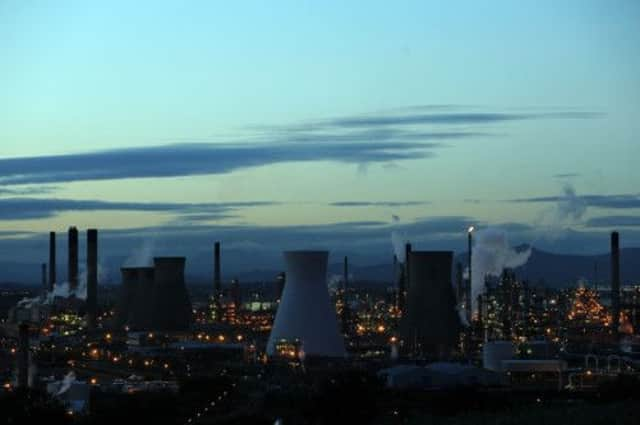Grangemouth: Ineos reveals blueprint for future


The massive plant, which was at the centre of a major industrial relations dispute last month, is set to be the first in the country to receive shale gas from the US.
Owner Ineos hopes the plan will reverse crippling losses and secure the future of the site.
Advertisement
Hide AdAdvertisement
Hide AdGrangemouth has been thrust into the limelight in recent months after one of the most bitter labour disputes for many years saw it teeter on the brink of closure before a deal was struck between management and unions.
The “survival” deal meant cuts in pay and conditions for workers, but also gave the green light to the massive investment to overhaul the way Grangemouth does business.
A huge new 40-metre high storage tank which can hold 33,000 tonnes of liquefied ethane – the biggest of its kind in Europe – is at the heart of the plans and will be completed in 2016 with a price tag of £125m.
The changes will also see new docking facilities on the nearby banks of the Forth for two ships Ineos is having specially built to transport the lucrative ethane gas to Scotland.
There is also to be an overhaul of the current “cracker”, which breaks the gas down and allows it be used in the plastics, cosmetics and pharmaceutical industries.
The changes mean other parts of the current Grangemouth site will be scaled down.
Contracts are also being negotiated in the US to create the infrastructure that will allow the gas to be shipped abroad. Loans are also being agreed to finance the project.
Calum MacLean, chairman of Grangemouth Petrochemical UK said: “It is sustainable, there is gas there. This investment is absolutely critical for Grangemouth.”
Advertisement
Hide AdAdvertisement
Hide AdIt means that immediately after the changes have been finished, the Scottish plant will be able to consume about 400,000 tonnes of ethane from the US.
“None of the contracts are signed and sealed yet,” Mr Mac-Lean said. “We’re in the process, but until you get the investment – until you hit the button to make that investment, everything has got to go in parallel.”
Ineos chiefs insist it would have spelled the end for Grangemouth if it was left to rely on the dwindling North Sea supplies, as refinery and petrochemical plants continue to close around Europe because there are simply too many.
Without the shale gas imports, “the petrochemical plant is not sustainable beyond 2017” Mr MacLean added.
“After what has been a very difficult three months at Grangemouth it is very reassuring for our employees to see real progress being made on the tank and infrastructure project.”
The firm announced it would close the petrochemical plant after reaching an impasse with the Unite union over the change to conditions, before the union backed down prompting a U-turn from the firm.
The new look-Grangemouth is set to be up and running by 2016 at which point Ineos chiefs are confident the plant can return to profit. In the meantime, it is likely to suffer heavy losses which have hit about £150m annually in recent years.
The UK and Scottish governments have both bought into the future strategy, with Westminster underwriting £150m in loan guarantees for Ineos, while Holyrood has handed over £9 million in regional selective assistance to the firm.
Advertisement
Hide AdAdvertisement
Hide AdThe firm is now close to completing a plant at Rafnes in Norway which will be the first in Europe to use exported shale gas from the US. It should be up and running in 2015, a year before Grangemouth and will provide the model for the Scottish plant.
“The ability to bring shale economics to Europe is fast becoming a reality,” Mr MacLean added.
“By applying the same approach we can make Grangemouth a great Scottish success story.”
Unite Scottish secretary Pat Rafferty said: “We shouldn’t forget that this new facility has only been made possible because of the welcome investment by Scottish and UK taxpayers and the sacrifice of the workforce.
“As the consultation on Ineos’ survival plan ends it is becoming clear that part of this sacrifice is the closure of some of the site’s plants and job losses. Ineos needs to come clean over job losses, the timescales involved and provide assurances to workforce this Christmas.”
Background: Norway’s firms ‘trust’ unions
The bitter dispute which engulfed Grangemouth contrasts starkly with the more co-operative approach to industrial relations in Norway.
Union representatives – by law – have a seat on the board of Ineos’ businesses in the Scandinavian country and play a key role in decisions at the plants.
Both sides put this down to a greater sense of “trust” between management and union leaders. Despite the closure of some facilities in recent years at the Grenland site, which includes the Rafnes plant and employs 620 staff, the kind of bitter strike action witnessed in Scotland has not materialised.
Advertisement
Hide AdAdvertisement
Hide AdWenche Tveitan, a union rep at the Noretyl site and a board member at O&P, said: “This is a different culture. You are talking together [with management] and the goal is the same. In Grangemouth, you don’t co-operate like you do in Norway.”
John Selmer, a rep and board member at Ineos Norge, said he has even “signed off bank loans” which the firm has taken out to invest in the facility.
“That’s the rules in our work – that employees take a part in the future.”